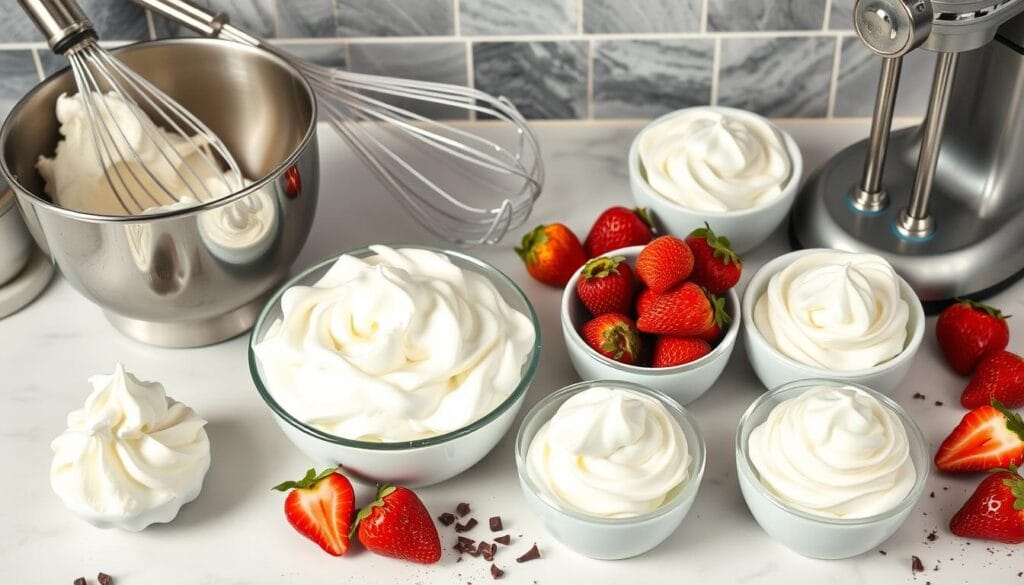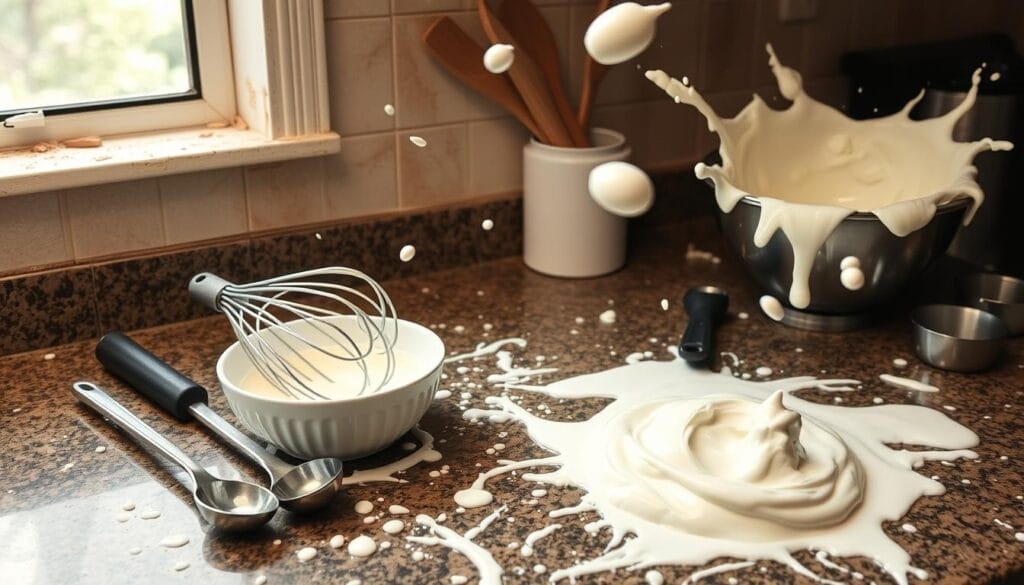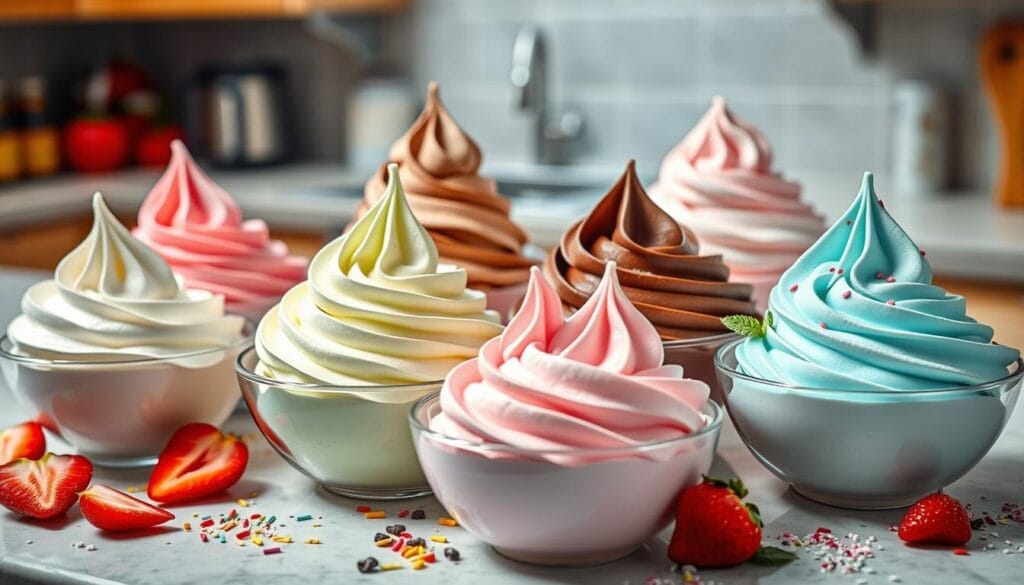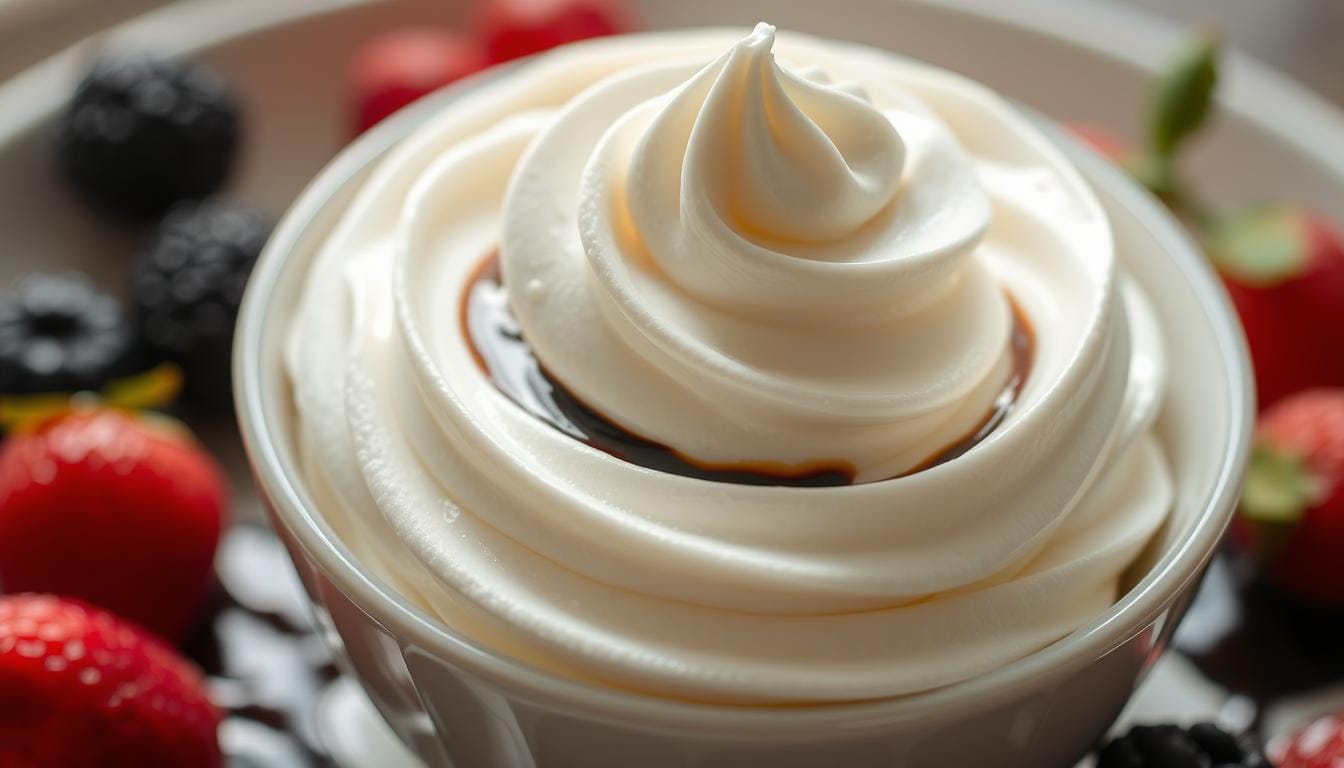I love desserts, and whipped cream is my favorite. It makes simple treats special. A dollop of whipped cream can turn a cake, hot chocolate, or berries into something amazing. If you love whipped cream as much as I do, you’re in the right place. We’ll explore how to make perfect homemade whipped cream. You’ll learn the science, tools, and techniques needed. Soon, you’ll be whipping up delicious cream that will wow everyone.
Let’s start learning how to make whipped cream that’s light and fluffy. It’s time to make your desserts even more special. Get ready for homemade whipped cream that’s pure joy.
Understanding homemade Whipped Cream: Basics You Need to Know
Homemade Whipped cream is a delightful and versatile ingredient that can elevate both sweet and savory dishes. To master the art of whipping cream, it’s essential to understand the science behind it and the key factors that contribute to its success. Let’s dive into the basics you need to know.
The Science Behind Whipping
The process of whipping cream involves transforming liquid cream into a light, airy, and stable foam. This transformation occurs when the fat molecules in the cream align around air bubbles. It creates a network that traps the air and increases the volume of the cream. The end result is a fluffy, creamy topping that can be used in a variety of culinary applications.
Types of Cream Suitable for Whipping
Not all creams are created equal when it comes to whipping. The ideal cream for whipping has a high-fat content, usually between 30% and 36%. Heavy cream or heavy whipping cream are the most suitable choices, as they contain the necessary fat content to whip up into a thick, stable foam. Lower-fat creams, such as light or half-and-half, may not whip as effectively or hold their shape as well.
Importance of Temperature
Temperature plays a crucial role in the whipping process. Both the cream and the equipment used should be well-chilled before whipping. Cold temperatures help the fat molecules in the cream firm up, making it easier to whip and resulting in a thicker, more stable whipped cream. Avoid whipping cream at room temperature, as it will not achieve the desired consistency.
| Whipping Cream Basics | Details |
|---|---|
| Ideal Cream Fat Content | 30% – 36% |
| Recommended Whipping Ratio | 1 cup heavy cream, 1-2 tbsp sugar, 1/2 tsp vanilla |
| Whipped Cream Yield | 1 cup heavy cream yields approximately 2 cups whipped cream |
| Calorie and Nutrient Content | 107 kcal, 2g carbs, 1g protein, 11g fat (7g saturated), 41mg cholesterol, 1g sugar, 437IU Vitamin A, 1mg Vitamin C, 19mg Calcium |
| Storage and Shelf Life | Refrigerated whipped cream can be stored for several days, but is best used immediately for optimal results |
By understanding the science behind whipping cream, the types of cream suitable for the task, and the importance of temperature, you’ll be well on your way to creating perfectly whipped cream every time.
Essential Tools for Perfect homemade Whipped Cream
Creating fluffy whipped cream needs the right tools. You’ll need a good mixing bowl and the right whisk or mixer. The tools you pick can change how your whipped cream turns out.
Choosing the Right Mixing Bowl: homemade Whipped Cream
The mixing bowl is key for whipping cream. Choose a cold, stainless steel bowl. It keeps the cream cold and helps it whip up better. Don’t use plastic or light bowls as they can’t keep the cream cold enough.
Selecting Whisks and Mixers: Hand vs. Electric
A balloon whisk is great for manual whipping. Its wide wires and gentle motion add air to the cream, making it light and fluffy. Electric hand mixers whip cream fast, in under 2 minutes. For big batches, a stand mixer is a must, as it works without your hands and gives consistent results.
Optional Tools for Convenience: homemade Whipped Cream
- Whipped cream dispensers with nitrous oxide cartridges make cream fluffy in seconds.
- Piping bags and nozzles are key for decorating cakes, cupcakes, and pies with fancy designs.
- When mixing whipped cream into other ingredients, use a figure-eight motion to mix evenly without overworking.
Using the right tools can make your whipped cream perfect every time. Whether you like doing it by hand or using electric mixers, pick what works best for you. The goal is to get the whipped cream just right.

Preparing the Ingredients for Success
Creating the perfect whipped cream starts with the right ingredients. Choosing the best cream and adding flavors are key. Each step is important for that light, fluffy texture.
Selecting Fresh Cream: homemade Whipped Cream
Start with high-quality, fresh cream for the best whipped cream. Look for heavy cream with at least 36% fat. This ensures a thick, creamy texture. Regular whipping cream works too, but it might take longer.
Flavoring Options: Vanilla, Chocolate, and More
After picking your cream, it’s time to add flavors. Vanilla extract is a classic choice, adding a warm taste. For a sweet treat, try melted chocolate or cocoa powder. You can also add citrus zests for a refreshing twist.
Sweetening Your homemade Whipped Cream
Adding a bit of sweetness balances the cream’s richness. Powdered sugar is a great choice, dissolving smoothly. Granulated sugar works too, but it might feel grittier. Natural sweeteners like honey or maple syrup are healthier options. Just be careful when adding sweeteners to avoid changing the texture.
With the right cream, flavors, and sweeteners, you’re ready to make delicious whipped cream. It will take your desserts, drinks, and even savory dishes to the next level.
Techniques for Whipping Cream
Mastering the art of whipping cream is key to its versatility. You can choose between hand-whipping or using electric mixers. Each method has its own benefits, leading to perfect whipped cream every time.
Hand Whipping: A Traditional Method
Hand whipping is a classic technique that gives you full control. Use a balloon whisk and a cold bowl to whip the cream. It takes effort, but you can stop when it’s just right.
Electric Mixers: Speed and Efficiency
Electric mixers make whipping cream easy and quick. Stand mixers are especially good because of their adjustable speeds. They help you whip cream to the perfect consistency without much effort.
Alternative Methods: Blenders and Food Processors
Blenders and food processors can also whip cream, though less commonly. They whip cream fast, but watch it closely to avoid over-whipping. They’re great for small batches.
Start slow with any method to avoid lumps. Gradually increase speed as the cream thickens. With practice, you’ll whip cream to perfection every time.
| Method | Time to Soft Peaks | Time to Medium Peaks | Time to Stiff Peaks |
|---|---|---|---|
| Hand Whipping | 4 minutes | 5 minutes | 5.5 minutes |
| Stand Mixer | 1-2 minutes | Varies by speed | Varies by speed |
| Blender | 10 seconds | 20 seconds | 30 seconds |
| Food Processor | 30 seconds | 45 seconds | 60 seconds |

Perfect whipped cream comes from finding the right method for you. Try different techniques to find your favorite way to whip cream.
Common Mistakes to Avoid When Whipping Cream
Making perfect whipped cream is an art. But, with the right techniques, you can dodge common mistakes. One big error is overwhipping. Overbeating turns cream into a thick, grainy mess, far from the light, airy texture you want.
Overwhipping: Identifying the Signs
To prevent overwhipped cream, watch the whipping closely. Look out for a grainy texture and cream separation. Stop when the cream forms soft peaks or firm peaks for a stiffer cream.
Failing to Chill Ingredients
Another mistake is not chilling cream and tools before whipping. Cold ingredients are key for the right texture. Don’t rush it; chill everything properly before whipping.
Skipping the Sweetener
It might seem easy to skip adding sugar. But, a bit of sugar enhances flavor and stability. Use two to four tablespoons of sugar per cup of cream, adjusting to taste.
By avoiding these mistakes and focusing on the whipping process, you’ll make perfect whipped cream every time.

Creative Variations to Try
Make your desserts and drinks more exciting with flavored whipped cream. Try adding different flavors, fruits, and spices to your whipped cream. You can go from citrusy to chocolatey, and everything in between.
Flavored Whipped Cream Options
Begin with classic flavors like vanilla, almond, or liqueur. Vanilla extract or vanilla bean paste add a cozy touch. For a fancy twist, mix in citrus zest like orange or lemon. This adds a bright, tangy taste that’s perfect with sweet treats.
Incorporating Fruits and Spices
Use whipped cream as a base for fruit flavors. Mix in pureed berries like strawberries or raspberries for a sweet surprise. Or, add spices like cinnamon, nutmeg, or cardamom for a unique taste. These spices can take your whipped cream to the next level.
Decadent Chocolate Whipped Cream
For a treat, try chocolate whipped cream. Melt good-quality chocolate, let it cool, then mix it into your whipped cream. This creates a rich, chocolatey flavor that’s great on cakes, pies, and even hot drinks.
With a bit of creativity and the right ingredients, you can make amazing whipped cream. It’s a great way to add something special to your desserts and drinks.

Storing Whipped Cream for Later Use
Keeping your homemade whipped cream fresh is key. With a few easy steps, you can enjoy it for days or even weeks.
Best Practices for Refrigeration
Store whipped cream in an airtight container in the fridge. This keeps it from drying out or picking up bad tastes. Whipped cream stays good for up to 24 hours, but it might get denser and less fluffy.
How to Freeze Whipped Cream
- Freezing whipped cream is a great way to keep it longer. But, it might change its texture a bit.
- To freeze, use a piping bag or dollop it on a baking sheet in small amounts. Then, move it to an airtight container or freezer bag once it’s frozen.
- Frozen whipped cream lasts 3 to 4 months. But, it’s best to use it in 2 to 3 months for the best taste and texture.
Maintaining Texture After Thawing
When you’re ready to use frozen whipped cream, thaw it in the fridge. This slow thawing keeps the texture right. Adding gelatin or cornstarch can also help keep it fluffy during freezing and thawing.
By following these tips, you can enjoy whipped cream for a long time. Whether you store it in the fridge or freeze it, the right storage keeps it fresh and tasty.
Whipped Cream in Recipes
Whipped cream is a versatile ingredient that can make many recipes better. It can be used on desserts and drinks or in cakes and pastries. This creamy delight adds richness and flavor to any dish.
Topping Desserts and Beverages
Whipped cream is a classic choice for pies, ice cream sundaes, and hot chocolate. Its light texture complements the sweetness of these treats well. Make sure to whip the cream until it’s stiff to keep it from falling.
Using in Cakes and Pastries
In cakes and pastries, whipped cream can be a filling or frosting. It adds a creamy contrast to the baked goods. It works well with many flavors, from vanilla to chocolate. Make sure to stabilize it so it doesn’t collapse.
Incorporating into Savory Dishes
Whipped cream can also be used in savory dishes. It adds creaminess to soups, sauces, and main dishes. Be careful with the sweetness and adjust the flavors to get the right balance.
Whipped cream is great for topping desserts, filling pastries, or adding creaminess to savory dishes. With a little practice and creativity, you can use it in many dessert toppings and savory whipped cream recipes.
Troubleshooting Common Issues
Whipping up whipped cream can sometimes be tricky. Issues like a grainy texture or separation can be frustrating. But, with the right techniques, you can fix these problems quickly.
Grainy Texture: Causes and Solutions
A grainy texture usually comes from overwhipping or temperature changes. If your whipped cream looks gritty, try adding a bit of unwhipped cream. This can make it smooth again.
Also, make sure everything is cold before whipping. This helps avoid a grainy texture.
Separation Problems: How to Fix
Cream separation can happen if the cream is old or overwhipped. Start fresh with cold, full-fat cream. Stop whipping when it’s just right.
If it separates again, add a bit of unwhipped cream. This helps mix it back together.
Handling Excessive Sweetness
Whipped cream can sometimes be too sweet. To fix this, add a pinch of salt or some unsweetened whipped cream. This balances the flavors.
FAQ
What is the science behind whipping cream?
Whipped cream forms when fat molecules in cream line up around air bubbles. This creates a stable foam. The process involves creating a network of fat molecules to trap air.
What types of cream are suitable for whipping?
Heavy cream or heavy whipping cream with 30-36% fat content is best for whipping. You can also use heavy cream, whipping cream, or double cream.
Why is temperature important when whipping cream?
Temperature is key for the best homemade whipped cream. Cold equipment and ingredients are essential for proper whipping.
What are the essential tools for whipping cream?
You’ll need a cold, stainless steel bowl and chilled utensils like a balloon whisk. Electric mixers, both hand-held and stand, make whipping easier and faster.
How do I select fresh, high-fat content cream for whipping?
Choose fresh, high-fat content cream for the best homemade whipped cream. You can add flavors like vanilla extract, citrus zest, chocolate, or cocoa.
What are the different methods for whipping cream?
You can whip cream by hand, with electric mixers, or even blenders or food processors. Start at low speed and gradually increase to medium.
What are common mistakes to avoid when whipping cream?
Avoid overwhipping, not chilling ingredients and equipment, and adding sweetener at the wrong time. These can affect the texture and quality of homemade whipped cream.
How can I create flavored or specialty whipped creams?
Try adding flavors like vanilla, citrus, or liqueurs. You can also incorporate fruits and spices, or make decadent chocolate whipped cream.
How do I properly store whipped cream?
Store whipped cream in an airtight container in the fridge for up to 24 hours. Freezing can change the texture. Stabilizers like gelatin or cornstarch can help maintain texture during storage.
How can I use whipped cream in recipes?
Whipped cream is versatile. Use it to top desserts, fill cakes and pastries, or even in savory dishes like soups or sauces. Adjust sweetness and flavoring as needed.
How can I fix common issues with whipped cream?
For a grainy texture, gently fold in a little unwhipped cream. If it separates, start over with fresh, cold cream. Excessive sweetness can be balanced by adding a pinch of salt or unsweetened whipped cream.

